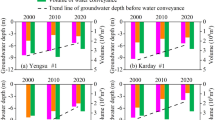Abstract
An open channel flow model, calibrated against field data, suggests that cattle intrusion in the eastern Usangu wetlands, as well as both dry and wet weather irrigation upstream, are responsible for the seasonal drying out of the Great Ruaha River (GRR) downstream. This human-induced change has severe socio-economic implications downstream, including hindering hydroelectricity production, as well as a devastating impact on the Ruaha National Park (RNP) ecosystem that is now shifting from wet tropics to dry tropics. To ensure sustainable development, governance is urgently needed for the Usangu catchment in a way that is compatible with ecohydrology principles for the sustainable use of water resources. In order to do that, perennial flow must be restored to the GRR. For this to happen this study suggests that all the livestock must be removed from the eastern Usangu wetlands and dry weather irrigators must return at least 25% (∼4 m3 s−1) of the water to the river.
Similar content being viewed by others
References
Arcement Jr. G.J. and Schneider V.R. 2004. Guide for Selecting Manning’s Roughness Coefficients for Natural Channels and Flood Plains. United States Geological Survey Water-supply Paper 2339, Washington DC, 67 pp
Bauer P., Thabeng G., Stauffer F., Kinzelbach W. (2004). Estimation of the evapotranspiration rate from diurnal groundwater level fluctuations in the Okavango Delta, Botswana. J. Hydrol. 288: 344–355
Bullock A., Acreman M. (2003). The role of wetlands in the hydrologic cycle. Hydrol. Earth Syst. Sci. 7: 358–389
Chanson H. (2004). The Hydraulics of Open Channel Flows: An Introduction. Butterworth-Heinemann, Oxford UK 2nd edition, 585 pp
Coppolillo P.B., Kashaija L., Moyer D.C. and Knap E. 2004. Technical Report on Water Availability in the Ruaha River and the State of Usangu Game Reserve, November 2003. Wildlife Conservation Society and WWF-Tanzania Program
Crisman T.L., Chapman L.J., Chapman C.A., Kaufman L.S. (2003). Conservation, Ecology, and Management of African Fresh Waters. University Press of Florida, Gainesville, 514 pp
Confederation of Tanzania Industries. 2004. The Industrialization of Tanzania: Towards Poverty Alleviation. The Economic and Social Research Foundation, DANIDA. Dar Es Salaam
de Villiers M. (2000). Water: The Fate of our Most Precious Resource. Houghton Mifflin Company, Boston, 352 pp
Gereta E., Wolanski E., Borner M., Serneels S. (2002). Use of an ecohydrological model to predict the impact on the Serengeti ecosystem of deforestation, irrigation and the proposed Amala weir water diversion project in Kenya. Ecohydrol. Hydrobiol. 2:127–134
Harper D.M., Mavuti K.M. (2004). Lake Naivasha, Kenya: ecohydrology to guide the management of a tropical protected area. Ecohydrol. Hydrobiol. 4:287–305
Lankford B., van Koppen B., Franks T., Mahoo H. (2004). Entrenched views or insufficient science? Contested causes and solutions of water allocation; insights from the Great Ruaha River Basin, Tanzania. Agric. Water Manage. 69:135–153
McCarthy T.S., Ellery W.N. (1995). Sedimentation on the distal reaches of the Okavango Fan, Botswana, and its bearing on calcrete and silcrete (ganister) formation. J. Sediment. Res. 65:77–90
Mohamed Y.A., Savenije H.H.G., Bastiaanssen W.G.M., van den Hurk B.J.J.M. (2005). New lessons on the Sudd hydrology learned from remote sensing and climate modelling. Hydrol. Earth Syst. Sci. Discuss. 2:1503–1535
Moyer D.C. 2000. Avian Biodiversity of Ihefu swamp and floodplains in Usangu, Tanzania. Report to UK Department for International Development
Petryk S., Bosmajan G. (1975). An analysis of flow through vegetation. J. Hydraul. Div., Am. Soc. Civil Eng. 101: 871–874
Postel S., Richter B. (2003). Rivers for Life: Managing Water for People and Nature. Island Press, Washington, D.C., 220 pp
President’s Office. 2004. The Economic Survey 2004. The United Republic of Tanzania, Planning and Privatisation. Dar Es Salaam
SMUWC. 2002. The Sustainable Management of the Usangu Wetland and its Catchment. September 1998–March 2003. 20 volumes. UK Department of International Development and Ministry of Water and Livestock, Dar Es Salaam
Sosovele H. and Ngwale J.J. 2002. Socio- Economic Root Causes of the Loss of Biodiversity in the Ruaha Catchment Area. Report submitted to WWF – Tanzania
Wolanski E., Gereta E. (1999). Oxygen cycles in a hippo pool, Serengeti National Park, Tanzania. Afr. J. Ecol. 37:419–423
Wolanski E., Jones M., Bunt J.S. (1980). Hydrodynamics of a tidal creek-mangrove swamp system. Aust. J. Mar. Freshwater Res. 31:431–450
Wolanski E., Spagnol S., Thomas S., Alongi D.M., Trott L., Davidson A. (2000). Modelling and visualising the fate of shrimp pond effluent in a tidally flushed mangrove creek. Estuar.Coast. Shelf Sci. 50:85–97
Zalewski M. (2002). Ecohydrology – the use of ecological and hydrological processes for sustainable management of water resources. Hydrol. Sci. Bull. 47: 823–832
Author information
Authors and Affiliations
Corresponding author
Rights and permissions
About this article
Cite this article
Mtahiko, M.G.G., Gereta, E., Kajuni, A.R. et al. Towards an ecohydrology-based restoration of the Usangu wetlands and the Great Ruaha River, Tanzania. Wetlands Ecol Manage 14, 489–503 (2006). https://doi.org/10.1007/s11273-006-9002-x
Received:
Accepted:
Published:
Issue Date:
DOI: https://doi.org/10.1007/s11273-006-9002-x




